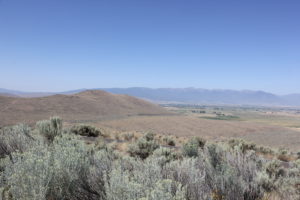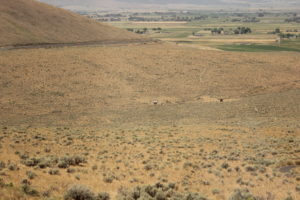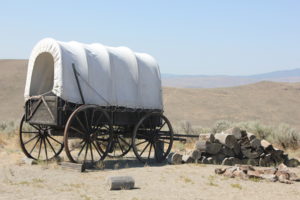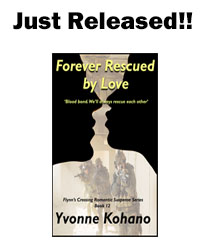I’m working on a new series set in Portland about a wealthy extended family who are descendants of founding settlers of Oregon. Immersing myself in the history and lore to better define my characters has been fun, particularly since it allows me to learn more about my (relatively new) home. I ran across two inspirations on our recent visit to eastern Oregon – the Oregon Trail, and century ranches.
(See Century Ranches, Part 2, here.)

Westward Ho
When emigrants following the Oregon Trail first set their feet in what is the modern-day state, they likely crested a butte east of Baker City. Marks of the wagon wheels are still visible as deep grooves carved in the dry soil. While the Powder River provides much-needed water to the valley in this sagebrush-styled desert, settlers didn’t linger. At that time, this location looked like countless others along their arduous route. They crossed the John Day too. With more hills and mountains on the horizon and the knowledge that they were a distance from their destination in the Willamette Valley, they moved on.
 Today, some of their stories are memorialized in the National Historic Oregon Trail Interpretive Center. Set on Flagstaff Hill and providing an overlook of a section of original ruts, the Center tells about their journeys through the eyes of characters who left behind their words for us to hear today. It also features trails leading to close views of the ruts, and with the remnants of gold mining in the area.
Today, some of their stories are memorialized in the National Historic Oregon Trail Interpretive Center. Set on Flagstaff Hill and providing an overlook of a section of original ruts, the Center tells about their journeys through the eyes of characters who left behind their words for us to hear today. It also features trails leading to close views of the ruts, and with the remnants of gold mining in the area.
 The stories were what captivated me. Can you imagine walking from St. Louis to Portland in the summer, wearing multiple layers of clothing covering you from head to toe? Your oxen or mules couldn’t drag your wagon much further, so you walked alongside, through rough vegetation often as tall as you. Your inadequate food spoiled. Water wasn’t always readily available, and it wasn’t always drinkable when it was. Children and old people often fell victim to the harsh conditions, and no family was untouched by death.
The stories were what captivated me. Can you imagine walking from St. Louis to Portland in the summer, wearing multiple layers of clothing covering you from head to toe? Your oxen or mules couldn’t drag your wagon much further, so you walked alongside, through rough vegetation often as tall as you. Your inadequate food spoiled. Water wasn’t always readily available, and it wasn’t always drinkable when it was. Children and old people often fell victim to the harsh conditions, and no family was untouched by death.
You traveled through deep rivers when you didn’t know how to swim. The Continental Divide (around 7500 feet in elevation) was only one of the mountain barriers in your way. The steep slopes downhill on the other side presented its own set of challenges. For long stretches, the graves alongside outnumbered animals to eat. When you arrived, you had little money left to begin anew, having spent it all to outfit your six-month journey. You had to leave part of those goods along the way because your animals could no longer carry it.
Those early settlers were made of steely stuff! As strong and determined my characters think they are in the present day, they’re wimps compared to their forbearers. Not only did they carry on in the face of dangers, sickness and loss, they often found ways to prosper. More about what they found in their new lives in Part 2.
Where do you think those early settlers got their courage? What can we learn from them to apply in our modern times? My characters want to know!
